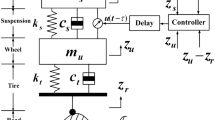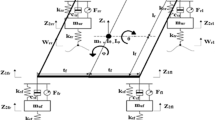Abstract
A new adaptive robust control strategy based on road level estimation for heavy rescue vehicles is proposed in this study. Firstly, a new road estimation method that considers the interaction between roads and vehicles is presented as a means of road level detection. A relative roughness indicator caused by different road levels is used as a basis for estimation. T-S fuzzy controller is designed to estimate the final road level. Secondly, an adaptive optimal H∞controller is established by selecting the corresponding parameter matrix based on an estimated road level. A robust control strategy is formulated to calculate the control force that can realise the adaptive control of an active suspension when driving on different road levels. Finally, experiment results show that an active suspension control system based on road level estimation can adaptively control suspension stiffness and damping by adjusting the parameter matrix of a robust controller. The proposed control strategy can improve ride comfort and handling stability in different road levels.
Similar content being viewed by others
References
Ahadian, M. and Pare, C. A. (2000). A quarter-car experimental analysis of alternative semi-active control methods. J. Intelligent Material Systems and Structures 11,8, 604–612.
Ahlin, K., Granlund, J. and Lindström, F. (2004). Comparing road profiles with vehicle perceived roughness. Int. J. Vehicle Design 36,2–3, 270–286.
Aly, A. A. and Salem, F. A. (2013). Vehicle suspension systems control: review. Int. J. Control, Automation, and Systems 2,2, 46–54.
Ambrož, M., Šušteršič, G. and Prebil, I. (2007). Creating models of road sections and their use in driving dynamics simulations. Vehicle System Dynamics 45,10, 911–924.
Bogsjö, K., Podgórski, K. and Rychlik, I. (2012). Models for road surface roughness. Vehicle System Dynamics 50,5, 725–747.
Caponetto, R., Diamante, O., Fargione, G., Risitano, A. and Tringali, D. (2003). A soft computing approach to fuzzy skyhook control of semiactive suspension. IEEE Trans. Control Systems Technology 11,6, 786–798.
Cremean, L. B. and Murray, R. M. (2006). Model-based estimation of off-highway road geometry using single-axis ladar and inertial sensing. Proc. 2006 IEEE Int. Conf. Robotics and Automation, Orlando, FL, USA.
Du, H., Sze, K. Y. and Lam, J. (2005). Semi-active H∞ control of vehicle suspension with magneto-rheological dampers. J. Sound and Vibration 283,3–5, 981–996.
Els, P. S. (2005). The applicability of ride comfort standards to off-road vehicles. J. Terramechanics 42,1, 47–64.
Feng, J., Zhang, X., Guo, K., Ma, F. and Karimi, H. R. (2013). A frequency compensation algorithm of four-wheel coherence random road. Mathematical Problems in Engineering, 2013, 1–12.
Gillespie, T. D., Paterson, W. and Sayers, M. W. (1986). Guidelines for conducting and calibrating road roughness measurements (English). World Bank Technical Paper. WTP46.
Gobbi, M. and Mastinu, G. (2001). Analytical description and optimization of the dynamic behaviour of passively suspended road vehicles. J. Sound and Vibration 245,3, 457–481.
Hassan, R. and Evans, R. (2013). Road roughness characteristics in car and truck wheel tracks. Int. J. Pavement Engineering 14,8, 736–745.
Hillel, A. B., Lerner, R., Levi, D. and Raz, G. (2014). Recent progress in road and lane detection: a survey. Machine Vision and Applications 25,3, 727–745.
Hong, K. S., Sohn, H. C. and Hedrick, J. K. (2002). Modified skyhook control of semi-active suspensions: a new model, gain scheduling, and hardware-in-the-loop tuning. J. Dynamic Systems, Measurement, and Control 124,1, 158–167.
International Organization for Standization (1995). Mechanical vibration—Road surface profiles—Reporting of measured data. ISO 8608: 1995.
Karnopp, D., Crosby, M. J. and Harwood, R. (1974). Vibration control using semi-active force generators. J. Manufacturing Science and Engineering 96,2, 619–626.
Lauwerys, C., Swevers, J. and Sas, P. (2004). Design and experimental validation of a linear robust controller for an active suspension of a quarter car. Proc. 2004 American Control Conf., Boston, MA, USA.
LevuLytė, L., Žuraulis, V. and Sokolovskij, E. (2014). The research of dynamic characteristics of a vehicle driving over road roughness. Eksploatacja i Niezawodnosc — Maintenance and Reliability 16,4, 518–525.
Li, Z., Zhang, W., Liu, Q. and Dong X. (2006). Study on road roughness recognition based on analysis of wheel vertical dynamic load. Chinese J. Scientific Instrument, S3.
Marzbanrad, J., Ahmadi, G., Zohoor, H. and Hojjat, Y. (2004). Stochastic optimal preview control of a vehicle suspension. J. Sound and Vibration 275,3–5, 973–990.
Múčka, P. (2004). Road waviness and the dynamic tyre force. Int. J. Vehicle Design 36,2–3, 216–232.
Németh, B. and Gáspár, P. (2010). Considering predicted road conditions in vehicle control design using H∞ method. IFAC Proc. Volumes 43,7, 396–401.
Nguyen, L. H., Hong, K. S. and Park, S. (2010). Road-frequency adaptive control for semi-active suspension systems. Int. J. Control, Automation and Systems 8,5, 1029–1038.
Pazooki, A., Rakheja, S. and Cao, D. (2012). Modeling and validation of off-road vehicle ride dynamics. Mechanical Systems and Signal Processing, 28, 679–695.
Qin, Y., Dong, M., Zhao, F., Langari, R. and Gu, L. (2015). Road profile classification for vehicle semi-active suspension system based on adaptive neuro-fuzzy inference system. 2015 54th IEEE Conf. Decision and Control (CDC), Osaka, Japan.
Sankaranarayanan, V., Emekli, M. E., Gilvenc, B. A., Guvenc, L., Ozturk, E. S., Ersolmaz, E. S., Eyol, I. E. and Sinal, M. (2008). Semiactive suspension control of a light commercial vehicle. IEEE/ASME Trans. Mechatronics 13,5, 598–604.
Sinha, P. K. and Pechev, A. N. (2004). Nonlinear H∞ controllers for electromagnetic suspension systems. IEEE Trans. Automatic Control 49,4, 563–568.
Sun, L., Zhang, Z. and Ruth, J. (2001). Modeling indirect statistics of surface roughness. J. Transportation Engineering 127,2, 105–111.
Wang, B., Guan, H., Lu, P. and Zhang, A. (2014). Road surface condition identification approach based on road characteristic value. J. Terramechanics, 56, 103–117.
Wang, D., Zhao, D., Gong, M. and Yang, B. (2018). Nonlinear predictive sliding mode control for active suspension system. Shock and Vibration, 2018.
Ward, C. C. and Iagnemma, K. (2009). Speed-independent vibration-based terrain classification for passenger vehicles. Vehicle System Dynamics 47,9, 1095–1113.
Yonglin, Z. and Jiafan, Z. (2006). Numerical simulation of stochastic road process using white noise filtration. Mechanical Systems and Signal Processing 20,2, 363–372.
Zhang, Y. and Alleyne, A. G. (2003). A new approach to half-car active suspension control. Proc. 2003 American Control Conf., Denver, CO, USA.
Zhang, Z. H. and Dong, M. M. (2008). Analysis on the optimal damping ratio on a 2 DOF linear model of vehicle suspension. Trans. Beijing Institute of Technology 28,12, 1057–1059.
Acknowledgement
This work was supported by the National Key R&D Program of China ‘Key Technology Research on Special Chassis and Suspension for High-mobility Emergency Rescue Vehicle (including Firefighting Vehicles)’ (Project No. 2016YFC0802900).
Author information
Authors and Affiliations
Corresponding author
Additional information
Publisher’s Note
Springer Nature remains neutral with regard to jurisdictional claims in published maps and institutional affiliations.
Rights and permissions
About this article
Cite this article
Gong, M., Yan, X. Robust Control Strategy of Heavy Vehicle Active Suspension Based on Road Level Estimation. Int.J Automot. Technol. 22, 141–153 (2021). https://doi.org/10.1007/s12239-021-0015-5
Received:
Revised:
Accepted:
Published:
Issue Date:
DOI: https://doi.org/10.1007/s12239-021-0015-5




